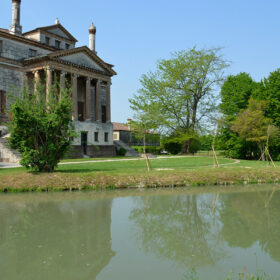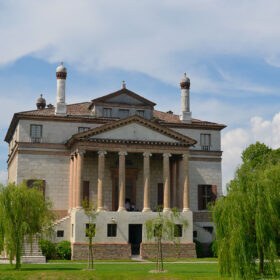
Descrizione
![]()
Opera del Palladio, dove è possibile notare il perfetto equilibrio e l’armonia fra l’architettura e il paesaggio circostante.
Nel 1500, la località dove sorge l’edificio, apparteneva alla famiglia Valier, mentre la gestione del territorio era stata affidata, dai proprietari, ai procuratori di San Marco. Successivamente i procuratori vendettero i lotti di terreno a Federico Foscari che morì nel 1527 lasciando i suoi beni ai figli Alvise, Giacomo e Ferigo. La villa fu commissionata da Nicolò e Alvise Foscari nel 1555, come ricorda anche Giorgio Vasari nel “Le vite de più eccellenti pittori scultori e architettori”, Firenze 1568. Nicolò morì prima di vederla completata. In suo ricordo fu realizzata un’iscrizione sulla facciata, sotto il timpano: “Nicolaus et aloysius Foscari fratres Federici Filii”. Verso la metà del 1600, la zona dove sorge la villa, diventa un vero e proprio centro e, dal 1700, si denunciano nella zona barchesse, stalle, osterie e casette. Sono giunte a noi alcune testimonianze iconografiche del XVIII secolo, realizzate dal Costa e dal Coronelli, in cui è possibile osservare come fosse sviluppata la piazza adiacente alla villa, circondata da casette collegate da separè ad arco, la presenza di una cappella e di una barchessa, e come tutta la zona fosse arricchita da elementi decorativi e pinnacoli.
Durante il periodo Napoleonico gli eredi lasciarono la villa abbandonata a sé stessa e in totale decadimento. Nei catasti del periodo austriaco del 1839 risultano ancora esistenti la villa e la cappella, ma già le casette e la piazza non sono più denunciate. Durante il periodo austriaco purtroppo furono danneggiati anche molti affreschi presenti nelle sale interne.
Dopo anni di totale decadimento la villa fu restaurata dall’Americano Albert Landsberg che la acquistò nel 1926. Un secondo restauro fu realizzato, grazie al contributo dell’ente delle ville venete, nel 1965. Dal 1974 fu riacquistata dai discendenti della famiglia Foscari.
Attualmente il complesso è costituito dalla villa, dalla barchessa e da un caseggiato annesso.
La struttura è costituita da un salone centrale a crociera, circondato da quattro sale e coperto da soffitti a volte. La facciata sul lato anteriore è caratterizzata da un’imponente loggia con colonne di ordine ionico. Si differenzia dalle altre opere del Palladio per la sua altezza, il Vasari precisava infatti che, “è alzata da terra 11 piedi”, a differenza delle altre alte solamente 5 piedi.
Gli affreschi furono iniziati dal pittore Battista Franco, dopo la sua morte furono continuati e completati dal noto pittore Giambattista Zelotto, con l’aiuto di Bernardino India. Le raffigurazioni rappresentano temi allegorici e mitologici, sfruttando i motivi architettonici dell’edificio creano un effetto illusionistico degli spazi. Gli affreschi del salone centrale, purtroppo, sono stati molto danneggiati, mentre giungono intatti quelli dei saloni laterali. Fra le opere più belle è ancora possibile ammirare la rappresentazione della “caduta dei giganti”.
In varie occasioni soggiornarono in questo incantevole luogo personaggi noti: il 27 luglio del 1574 sfilò con tutto il suo corteo il Re di Polonia Enrico III, che fu accolto nella villa con lunghi festeggiamenti; nel 1629 fu ospite Ferdinando Gran Duca di Toscana; nel 1685 Ernesto Augusto gran duca di Bunswich con la moglie; nel 1687 Cristiano Ernesto marchese di Brandemburgo; nel 1692 Augusto II re di Polonia; nel 1709 Federico IV re di Danimarca e Norvegia; nel 1717 Augusto IV di Polonia e poi ancora i De Brosses nel 1739 e la regina d’Inghilterra nel 1966.
![]()
The villa, designed by Palladio between 1555 and 1560, is considered one of the most brilliant works of the great architect. Admiring the building it is possible to notice the perfect balance and harmony between the architecture and the surrounding landscape.
In 1500, the location where the building stands belonged to the Valier family, while the management of the territory was entrusted by the owners to the procurators of San Marco. Subsequently the prosecutors sold the plots of land to Federico Foscari who died in 1527 leaving his assets to his sons Alvise, Giacomo and Ferigo. The villa was commissioned by Nicolò and Alvise Foscari in 1555, as Giorgio Vasari also remembers in “The Lives of the Most Excellent Painters, Sculptors and Architects”, Florence 1568. Nicolò died before seeing it completed. In his memory, an inscription was made on the facade, under the tympanum: "Nicolaus et aloysius Foscari fratres Federici Filii". Towards the middle of the 1600s, the area where the villa stands became a real center and, from the 1700s, barchesse, stables, taverns and houses were denounced in the area. Some iconographic testimonies of the eighteenth century have come to us, made by Costa and Coronelli, in which it is possible to observe how the square adjacent to the villa was developed, surrounded by houses connected by arched separè, the presence of a chapel and a barn , and how the whole area was enriched with decorative elements and pinnacles.
During the Napoleonic period the heirs left the villa abandoned to itself and in total decay. In the land registers of the Austrian period of 1839 the villa and the chapel still exist, but the houses and the square are no longer reported. Unfortunately, many frescoes in the interior rooms were also damaged during the Austrian period.
After years of total decay, the villa was restored by the American Albert Landsberg who bought it in 1926. A second restoration was carried out, thanks to the contribution of the Venetian villas body, in 1965. From 1974 it was bought back by the descendants of the Foscari family.
Currently the complex consists of the villa, the barn and an adjoining building.
The structure consists of a central cross-shaped hall, surrounded by four rooms and covered by vaulted ceilings. The facade on the front is characterized by an imposing loggia with Ionic columns. It differs from the other works of Palladio for its height, Vasari stated in fact that, “it is 11 feet raised from the ground”, unlike the other only 5 feet high.
The frescoes were begun by the painter Battista Franco, after his death they were continued and completed by the well-known painter Giambattista Zelotto, with the help of Bernardino India. The depictions represent allegorical and mythological themes, exploiting the building's architectural motifs to create an illusionistic effect of the spaces. Unfortunately, the frescoes in the central hall were badly damaged, while those of the side halls remain intact. Among the most beautiful works it is still possible to admire the representation of the "fall of the giants".
Famous people stayed in this enchanting place on various occasions: on July 27, 1574 the King of Poland, Henry III, paraded with his entire procession and was welcomed into the villa with long celebrations; in 1629 Ferdinando Gran Duca di Toscana was a guest; in 1685 Ernesto Augusto Grand Duke of Bunswich with his wife; in 1687 Cristiano Ernesto Marquis of Brandenburg; in 1692 Augustus II king of Poland; in 1709 Frederick IV, king of Denmark and Norway; in 1717 Augustus IV of Poland and then again the De Brosses in 1739 and the Queen of England in 1966.
Galleria immagini
Indirizzo
Via dei Turisti - Malcontenta di Mira
Contatti
Modalità d'accesso
Proprietà privata.
Aperta al pubblico.
Private property.
Open to the public.
Ulteriori informazioni
Info su: / Info on: www.lamalcontenta.com
Come arrivare/How to get
La frazione di Malcontenta dista circa 8 Kilometri dalla sede municipale del Comune di Mira. E’ possibile raggiungerla percorrendo la strada S.S. Romea in direzione Venezia: si imbocca la deviazione sulla destra per Malcontenta; poco prima delle chiuse sulla sinistra si scorge una strada sterrata che porta alla villa.
The hamlet of Malcontenta is about 8 kilometers from the municipal seat of the Municipality of Mira. It is possible to reach it by taking the S.S. Romea towards Venice: take the detour on the right for Malcontenta; just before the locks on the left you can see a dirt road leading to the villa.
Argomenti

